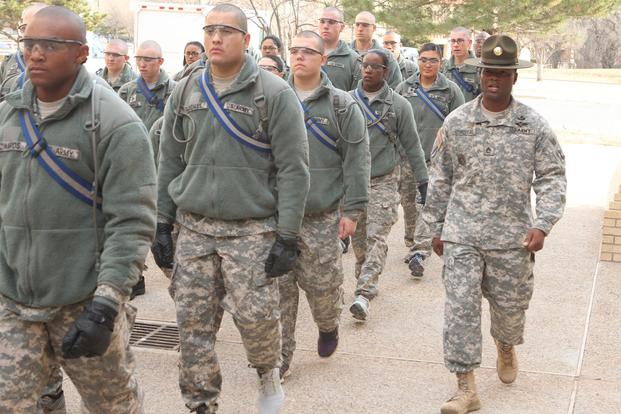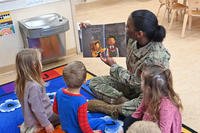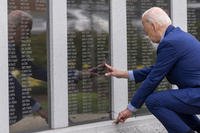The U.S. Army will soon launch a redesign of Basic Combat Training intended to build more discipline after many commanders complained that new soldiers often show up to their first units with a sloppy appearance and undisciplined attitudes.
By early summer, new recruits will go through Army BCT that's designed to instill strict discipline and esprit de corps by placing a new emphasis in drill and ceremony, inspections, pride in military history while increasing the focus on critical training such as physical fitness, marksmanship, communications and battlefield first aid skills.
Related content:
- Army Mulls Redesigning Basic Combat Training, General Says
- First Women Finish Army's Enlisted Infantry Training
- Army Basic Training PFT
The program will also feature three new field training exercises that place a greater emphasis on forcing recruits to demonstrate Warrior Tasks and Battle Drills, the list of key skills all soldiers are taught to survive in combat.
The new program of instruction is the result of surveys taken from thousands of leaders who have observed a trend of new soldiers fresh out of training displaying a lack of obedience and poor work ethic as well as being careless with equipment, uniform and appearance, Maj. Gen. Malcolm Frost, commanding general of the U.S. Army Center of Initial Military Training, told defense reporters on Friday.
'A Sense of Entitlement'
"What leaders have observed in general is they believe that there is too much of a sense of entitlement, questioning of lawful orders, not listening to instruction, too much of a buddy mentality with NCOs and officers and a lot of tardiness being late to formation and duties," Frost said. "These are trends that they see as increasing that they think are part of the discipline aspect that is missing and that they would like to see in the trainees that become soldiers that come to them as their first unit of assignment."
As commanding general of IET, Frost was tasked with increasing the quality of training and reducing new soldier attrition.
After compiling the data from surveys of about 27,000 commissioned officers, warrant officers and non-commissioned officers, the message was very clear, Frost said.
"The number-one thing that was asked for five-fold or five times as much as any of the other categories was discipline," Frost said.
"First-unit-of-assignment leaders want Initial Entry Training to deliver disciplined, physically-fit new soldiers who are willing to learn, they are mentally tough, professional and are proud to serve in the United States Army."
In addition to discipline and physical fitness, leaders also wanted technical and tactical proficiency in warrior tasks and battle drills.
Be a Soldier
After working out the details in a pilot at Fort Jackson, South Carolina, the Army has approved a new POI that Frost hopes will better instill into recruits exactly what it means to be a soldier.
"We really tried to attack it by getting after more discipline and esprit de corps," Frost said.
One new aspect features a series of history vignettes of major battles that the Army has fought in, from Valley Forge in the Revolutionary War all the way to Iraq in Baghdad, Frost said.
"We highlighted those battles; we tied them to Army Values and the Soldier's Creed and highlighted an individual who received the Medal of Honor or other valor award for actions during each battle," Frost said.
"So soldiers will learn across all of Basic Combat Training at all the Army training centers what it means to be a soldier, the history of the United States Army through the battles and the campaign streamers and the wars that we have fought and they will be able to look to and emulate a soldier who executed a valorous act during that war."
The new standardized booklet will be given to each recruit along with their Blue Book at the beginning of training.
Recruits will also learn discipline by doing more practice at a skill that may be as old as soldiering itself -- drill and ceremony.
Drill and Ceremony
When the war began after the attacks of 9/11, the Army decreased its focus on D&C, inspections and other skills that stress attention to detail to make more time for combat skill training.
"There are a lot of folks that say 'we need to go back to the drill and ceremony because we have lost a lot of the discipline aspect of what it means to be a United States Army soldier,'" Frost said.
"It's not like they are going to be sitting out there just doing D&C all the time. The drill and ceremony is going to be interwoven into when they move to and from places ... so the movements won't just be lollygagging, non-tactical movements, they will be actually executing some team drill and ceremony as they move to and from the chow hall and move to and from the barracks."
But the new BCT isn't all about spit and polish, Frost said.
Hammer, Anvil, Forge
"The other big piece we are doing in Basic Combat Training that helps with the esprit de corps and the discipline aspect and also lends a measure of grit and resilience to [BCT] is we have three major field training exercises that we are going to do now. We are calling them the Hammer, the Anvil and the Forge," Frost said, describing how the final Forge FTX is an homage to the Army's historic ties to Valley Forge.
"That is going to be a culminating FTX which is a graduation requirement. It will be an 81-hour field training exercise with about 40 miles of tactical road marching that is conducted through a series of tactical events and mini field training exercises."
The Forge will include a night infiltration course and a medical evacuation mass casualty exercise. There will be ethical dilemmas soldiers have to negotiate as well as a battle march and shoot, a resupply mission which involves moving supplies, ammo, water to a link-up point, patrol base activities, combat patrols as well as an obstacle course, Frost said.
"If you succeed in making it through the 81-hour FTX ... then what will happen is you will earn the right to become a soldier," Frost said. "You will earn your beret, you will earn a 'soldier for life' certificate, you will get your National Defense Service Medal and your uniform will look exactly like a United States Army soldier."
'Get After the Basics'
The new BCT POI weeded out "lot of redundant areas and areas that have crept in that did not get after the basics" -- shoot, move, communicate and protect or survive, Frost said.
For weapons qualification, recruits will be required to qualify with backup iron sights instead of just on close-combat optic sights.
Physical fitness standards will also be increased, requiring each soldier to score at least 60 points on all three events of the Army Physical Fitness Test instead of 50 points on each as a graduation standard.
Each recruit will also receive 33 hours of combatives training instead of 22 hours, Frost said.
Recruits will receive an increased amount of tactical combat casualty care training such as basic combat lifesaver.
The course will also teach "some of the basics that we had kind of lost with respect to communications such as basic hand and arm signals, and we have doubled the amount of basic reporting on the radio communications" such as MEDEVAC and similar requests, Frost said.
Some Qualifications Nixed
The new BCT does, however, do away with hand grenade qualification and land navigation course qualification as graduation requirements.
"What we have found is it is taking far, far too much time. It's taking three to four times as much time ... just to qualify folks on the hand grenade course than we had designated so what is happening is it is taking away from other aspects of training," Frost said.
"We are finding that there are a large number of trainees that come in that quite frankly just physically don't have the capacity to throw a hand grenade 20 to 25 to 30 meters. In 10 weeks, we are on a 48-hour period; you are just not going to be able to teach someone how to throw if they haven't thrown growing up."
Recruits will still receive the same amount of training in these areas, Frost said.
"Just because we took it off as a graduation requirement does not mean they won't be conducting hand grenade or land navigation training," Frost said. "They are going to learn all the technical aspects of the hand grenade, and they are going to learn tactical employment and they will throw a live hand grenade.
"With land navigation, it's the same thing they are still going to conduct land navigation training; they are still going to conduct the day course they are still going to conduct the night course."
The new changes to BCT, Frost said, will hopefully make new soldiers better prepared for their advanced individual training, first unit of assignment and result in a lower, new-soldier attrition rate
"If we can get a more physically fit, better prepared, more-disciplined soldier in Basic Combat Training, AIT and [One-Station Unit Training] then we believe we will have less attrition in first unit of assignment," Frost said.
-- Matthew Cox can be reached at matthew.cox@military.com.












